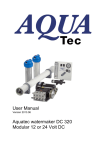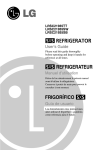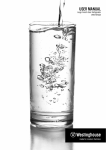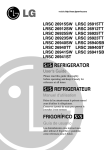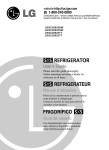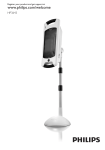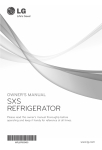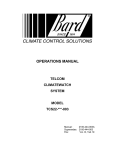Download CTA MASTERIA MPE 006 Instruction manual
Transcript
Instruction Manual MASTERIA compressed air dryer INSTALLATION, USE, MAINTENANCE Models MPE 006 to MPE 150 Climatic - Treatment of the Air ZA du caillou, 3 rue Jules Verne, 69630 CHAPONOST, FRANCE Phone: +33 (0)4 78.56.70.70 Fax: +33 (0)4 78.56.17.31 CTA Instruction Manual MPE Contents 1 Introduction 3 1.1 Principle 3 1.2 Originality 3 1.3 Standards 3 2 Safety 4 2.1 General precautions 4 2.2 Cooling fluid safety notice 5 3 Installation 6 3.1 Inspection 6 3.2 Handling 6 3.3 Layout 6 3.4 Electric connection 7 4 Use 8 4.1 First start up 8 4.2 Normal Start up 8 5 Programming 9 5.1 User interface 9 5.2 Changing set points 9 5.3 Changing purging duration 10 5.4 Purge test 10 5.5 Choice temperature unit 11 6 Maintenance preparation 6.1 Shut down and close all circuits 11 6.2 Access inside the drier 11 6.3 Closing 11 6.4 Start-up and return to the network 12 7 Maintenance operation 12 7.1 Cleaning the purge filter* 12 7.2 Solenoid valve maintenance * 13 8 Test and maintenance scheduling 13 9 Alarm 14 11 10 Components interns arrangement 14 11 Troubleshooting 15 12 Design specifications 17 13 Appendices 18 13.1 Use of a purge with a level detection function 14 Circuit diagrams 18 19 14.1 Refrigeration/pneumatic circuit diagram (SC0014A) 19 14.2 Wiring diagrams (SE00148, SE0015, SE0018, SE0017 and SE0018) 20 Reference: MT0027DA Revision date: 11/05/06 This document may be modified without prior notice Even partial reproduction is prohibited without authorisation in writing 2 CTA Instruction Manual MPE READ THIS MANUAL ATTENTIVELY BEFORE INSTALLING OR USING THE APPLIANCE ! These symbols inform you about dangers and the measures to be taken to avoid them. The comments in bold type emphasise the key points to observe to ensure you use your drier correctly. 1 Introduction 1.1 Principle Your Mastéria drier dries air by refrigeration. Hot, wet compressed air entering the Mastéria drier is cooled by an exchanger down to the programmed dew point temperature. The steam which condenses in liquid form during cooling is separated mechanically and is then purged by an electronic system with a time-out. The compressed air leaving the appliance is dry. 1.2 Originality Your Mastéria drier has several unique features compared with the other products on the market: • Reduced consumption due to an air-to-air heat exchanger in all models in the range above the MPE010. The dry, cold air from the drier is used to pre-cool the hot, wet air inlet. • Mechanical separation guaranteed in all operating modes by a condensate separator developed from 10 years experience. • High quality, anti-corrosion construction that is easy to maintain and very strong. • Electronic regulation with a user-friendly, clear, digital display panel. Finally, and especially, • DTM® technology, providing a host of additional benefits • Robustness: DTM® technology eliminates fragile, pressure-operated valves • Economy: DTM® technology only uses minimum power • Safety: DTM® technology guarantees the total integrity of the compressed air circuit from any risk of contamination by the cooling agent. This ensures that air quality meets the highest standards. • Performance: DTM® technology guarantees you get exactly the dew point you set. 1.3 Standards The air delivered by Mastéria dryers complies with ISO standards 85 731 and 7183. Mastéria range dryers comply with the following European directives: • 89/336: " Electromagnetic Compatibility " • 89/392/EEC: " Machine Safety " • 73/23/EEC: " Low Voltage" • 97/23/EEC : "Pressure Equipment" Reference: MT0027DA Revision date: 11/05/06 This document may be modified without prior notice Even partial reproduction is prohibited without authorisation in writing 3 CTA Instruction Manual MPE 2 Safety Everyone involved in installing, using and servicing Mastéria dryers is concerned by this manual and must have read and understood the instructions given below. ! Danger of electric shock and burns: every badly connected or misused electrical appliance is dangerous. For your personal safety and that of all the people who will approach this appliance, rigorously follow all the security instructions given in this manual. All interventions on the refrigeration circuit must be carried out by specialists. Every leak or anomaly must be pointed out to qualified people immediately. 2.1 General precautions Compressed gases which can be dried Your Mastéria drier is designed to dry compressed air. You must obtain prior authorisation from the manufacturer in writing before drying any other gas. Precautions to take before drying compressed air Ensure that the free parts of the components designed to expel the compressed air are blocked sufficiently to prevent whipping shocks caused by stiffening when the compressed air flows through them. Precautions during installation The installation must be carried out by qualified personnel reporting to a qualified supervisor. The power supply to the drier must be protected by thermal fuses or relays as shown in this manual. All the electric connections must be complying with local regulations. The drier and its auxiliaries must be earthed and protected from short-circuits and overloads. When the master switch is closed, the electric voltage reaches can kill. Consequently, take every precaution when working on the electric circuit. Do not open the electric circuit access panels with the equipment switched ON unless necessary for tests, measurements or adjustments. This task must only be carried out by qualified personnel, using the appropriate equipment and protected from the inherent dangers. For a single-phase power supply, fit a neutral conductor earthed in the transformer station (system TN as stipulated in IEC 364 - HD 384 - IEC 648) or by the electric power utility (TT system). In systems with several dryers, install manual valves so each machine can be isolated separately. Fit a safety valve to each tank or appliance containing air at a pressure higher than atmospheric pressure. Fit a safety valve between the compressor and the first by-pass valve. If raised access platforms are installed around the drier, take care that they do not impede use or access for lifting or dismantling components. Platforms and steps must be made from gratings or tiled, and be equipped with safety handrails on all open sides. Reference: MT0027DA Revision date: 11/05/06 Precautions during operation Dryers must only be operated by qualified personnel reporting to a qualified supervisor. If the temperature of pipework or any other parts which could be touched accidentally by the personnel during normal operation could exceed 60C° (140°F), they must be protected and insulated. All air pipes must be painted or clearly marked as stipulated in local safety regulations. Do not remove or touch the safety devices, protection or insulation fitted to the drier or its auxiliaries. Precautions for maintenance and repairs Dryer maintenance, revision and repair must be carried out by qualified personnel reporting to a qualified supervisor. When scrapping equipment, it must not pollute conduits or rivers. Do not burn materials which could pollute the air. Only use storage methods which respect the environment. Only use original spare parts supplied by the equipment manufacturer. Keep a log of all the interventions carried out on the drier and its auxiliaries. The frequency and the nature of the work completed during a given period can reveal abnormal operating conditions which require correction. Only use the cooling gas specified on the machine plate. Check that all instructions relating to operation and maintenance are respected and that the drier, the auxiliaries and all safety devices are serviceable. Always keep the drier clean. During maintenance work, protect the components and plug the openings exposed with clean rags, for example. Never weld or carry out work which releases heat in the vicinity of a system containing oil. Before carrying out such operations, all components which contain oil must be emptied and washed with steam, for example. To prevent operating temperature and pressure rises, check and clean all heat exchanger surfaces regularly, (for example, the condensing unit fins). Schedule cleaning for each drier. Take care not to jam the safety valves or other pressure limitation devices with paint, oil, dirt, etc. This document may be modified without prior notice Even partial reproduction is prohibited without authorisation in writing 4 CTA Instruction Manual Take all appropriate precautions when welding or carrying out any other repairs which release heat, flames or sparks. Protect all components in the vicinity with non-flammable material. Drain lubrication system parts or components containing oil if working close to them. Never use a naked flame as a light to inspect the drier. MPE If non-flammable chlorinated hydrocarbons are used for cleaning, take all safety precautions to prevent injury from the toxic vapours released. Before removing any panel or dismantling any part of the unit: 1. Turn off the power supply to the drier by setting the master switch to "OFF " and removing the fuses. Before dismantling a drier make sure that all the moving and heavy parts are attached. After the intervention, check that no tool rag or waste has been left inside. 2. Stick a label on the lever of the master switch and install a «WORK IN PROGRESS - DO NOT ENERGISE " warning panel. Do not touch the master switch and do not try to start the drier if the warning panel is in place. Check the direction of rotation of the electric motors, and, in particular, the fan, when starting the machine after an intervention on the electric connections or the power supply cut-out. 3. Close the by-pass valves up- and down-stream from the drier and install on each valve a “WORK IN PROGRESS - DO NOT OPEN " warning panel. Only reopen these valves when restarting the drier. All protection systems must be reset after repair or maintenance. 4. Check that all pressurised components in the system have reverted to atmospheric pressure. Check that all the pressure gauges indicate a pressure of zero bars, i.e. atmospheric pressure. Do not clean components with flammable liquids when the drier is operating. 2.2 Cooling fluid safety notice Mastéria dryers use a cooling gas of the type shown on the manufacturer's plate on the appliance. Very dirty refrigerating circuits, for example following a compressor fire, must only be cleaned by a qualified refrigeration technician. Comply with current safety laws and regulations. The refrigerant is not flammable, explosive, toxic or corrosive in normal conditions. When released into the atmosphere, it becomes a heavier-than-air and almost odourless vapour. In contact with a naked flame or a very hot metal surface, this vapour breaks down into highly irritant products which are immediately noticeable. If the refrigerant gas leaks, it is advisable to air the buildings concerned abundantly and to shut down all the systems likely to break down the vapours by flame or heat immediately. Every intervention on the cooling circuit must be carried out by qualified personnel approved by CTA. In the event of: • chilblains, warm up the frozen skin as soon as possible. • splashes in the eyes, rinse abundantly with running water. Then consult a doctor immediately. Reference: MT0027DA Revision date: 11/05/06 This document may be modified without prior notice Even partial reproduction is prohibited without authorisation in writing 5 CTA Instruction Manual MPE 3 Installation ! The installation procedures described in this chapter must only be executed by qualified personnel. The following procedure must be scrupulously respected or the safety of all staff could be at risk. 3.1 Inspection Immediately after unpacking the drier, check that it is undamaged. If necessary, make a damage claim to the carrier who delivered the equipment. ! Never install or use an appliance damaged during shipment. 3.2 Handling If using hoists to lift the equipment make sure they are safe. To prevent accidents, check that all chains, hooks, rings, slings, etc., are in good condition and suitable for the load. They must be tested and approved as stipulated in local safety regulations. Cables, chains and ropes should never be attached directly to the lift lugs. Always use a correctly positioned ring or a hook. Lay out the lift so that hoisting cables do not form excessively tight curves. Use a bar to avoid side loads on hooks and lugs. Stand at a safe distance away from the load while it is being lifted. Ensure that lift accelerations and velocities are within safety limits and never leave a load suspended longer than necessary. 3.3 Layout ! Throughout installation, stop compressed air production of to avoid risks to installation personnel. 1. The dryer should be installed on a flat surface suitable for the weight of the appliance in a closed, dry, room which cannot freeze. Access to the room must be restricted to qualified maintenance and test personnel. The room must be sufficiently ventilated with clean air free from flammable gases or solvents. The drier must not be exposed directly to heat sources. The temperature of the room must not exceed 43C°. Minimum and maximum ambient temperatures are specified on the manufacturer's plate on the drier. Unless otherwise stated, dryers are designed to function in ambient conditions at a temperature of 25C°. Higher temperatures may reduce the capacity of the drier and result in an increase in the dew point. Usually this does not cause a problem if the compressed air network is also in higher ambient temperature conditions. 2. Check that the drier is not surrounded by equipment which does not comply with European electromagnetic compatibility directives as interference could deteriorate appliance operation. Leave a minimum 1 m space between the drier and all other electrical appliances. 3. Leave adequate space around the drier for maintenance. Position the drier to ensure that cooling air cannot recirculate towards the suction ports. Check that the drier does not suck Reference: MT0027DA Revision date: 11/05/06 in hot air from the compressor cooling systems, the final cooler or any other appliance. Remark: The cooling air used by the dryer comes in by the rear grid and comes out by the front grid 4. The position of the drier in the compressed air distribution system depends on the way the compressed air will be used (see installation plan). − The drier must be installed downstream from the tank if the compressor pumps intermittently or if total demand for air does not exceed the total compressor flow rate capacity (the usual case). − The drier should be installed upstream from the tank if the tank has been dimensioned to permit wide fluctuations in compressed air demand or if peak demand exceeds maximum compressor flow rate capacity. 5. Fit by-pass valves between the drier inlet and exhaust so that maintenance can be carried out without having to shut down the compressed air supply to the network (see diagram below). During installation, the upstream and downstream valves must be closed. 6. Additional fittings - fit a class 4* type P solid pollutants filter (15m, µ8mg/m3) upstream from the drier - fit a class 1* type S total oil 1filter (0.01mg/m3) downstream from the drier to remove dust and oil from the compressed air. Only use filters equipped with an automatic purge system. This document may be modified without prior notice Even partial reproduction is prohibited without authorisation in writing 6 CTA Instruction Manual They must act directly on the tank with no intermediate position and possess a discharge capacity higher than the quantity of air inlet to the tanks, calibrated and sealed at the safety pressure of your network which must always be under 20 bars. 7. Connect the compressed air to be treated to the drier inlet (lower port) with pipes which do not place stresses and strains on the appliance. 8. The compressed air to be treated must be taken from the upper part of the tanks to reduce the risk of transporting liquid phase water or particles. This will extend the service life of the appliance. 9. Connect the treated compressed air to the exhaust side of the drier with pipes which do not place stresses and strains on the appliance. 10. If the compressed air production system is not fitted with a safety device (valve or pressure switch) you must fit a safety valve to each tank ! MPE 11. Check all connections for leaks. 12. Connect the drier and filter purge lines to your condensate treatment system (water/oil separation). Unless otherwise stipulated by applicable legislation, do not drain wastes to sewers without prior treatment. * see ISO standard 8573-1 For air dryer inlet and outlet connexion's tightening, be sure not to use too much screwing tight power which would damage the evaporator coil piping of the thermal mass. Upstream valve By-pass valve Down stream valve Air compressor Treated compressed Air Tank Water P S Upstream Filter Down stream filter Condensate separator Oil Typical layout 3.4 Electric connection ! Risk of electric shock: the circuit must be wired by a qualified electrician in compliance with applicable legislation and the specifications of the appliances to be connected. Check that voltage and frequency comply with the values shown on the manufacturer's plate on the machine and that they are within the tolerances shown on the electrical circuit diagram. Check that the electrical installation complies with laws and regulations current in the place where the drier will be installed. Only use the electric cable provided with the machine or equivalent. At the entry of the electric cable, a safety device must be installed for: • Protection from short-circuits and voltage surges; • Protection from the indirect contacts on the machine (short-circuit between phase and equipotential safety circuit) by automatically power supply cut-off as stipulated in IEC standard 364 - HD384 IEC 64-8; • Protection from the failure of one phase in a three-phase electric installation. For safety circuit dimensions, refer to the data shown in the electric diagram (maximum current, peak current, cable cross-section). Reference: MT0027DA Revision date: 11/05/06 This document may be modified without prior notice Even partial reproduction is prohibited without authorisation in writing 7 CTA Instruction Manual MPE 4 Use 4.1 First start up ! Only start up the drier once you have thoroughly tested all the hydraulic, refrigeration and electrical connections. 1. Close the isolating valves on the drier and open the by-pass valve. 2. Check that the master switch is set to O. 3. Start the air compressor 4. Set the master switch to I. The drier digital display panel comes ON. 5. The refrigerating compressor and the fan start after a 2 minute safety time-out. 6. Pressurise the drier by slowly opening the inlet valve. 7. Slowly open the drier exhaust valve and then close the by-pass. 8. The drier will operate until the digital display panel indicates 00°C (32°F). 9. The drier will then stop for at least 2 minutes and will only start again when the digital display panel indicates 04 °C (or 39°F). If the compressed air flow oscillates, it is normal for these values to be exceeded temporarily. 10. Check that the purge opens when the TEST button is pressed. 11. Check that the solenoid valve opens automatically every 5 minutes. The drier is now ready to run normally. 4.2 Normal Start up The following key points will optimise daily use: • Always turn your drier ON 5 to 10 minutes before the air compressor. In this way, your compressed air will be treated from the first m3. • Your appliance can remain ON even if compressed air production is stopped. Its electronic regulation will automatically start and stop it to meet demand. You only need to turn off your drier at night, at the weekend or when you go on holiday! • The standard drier parameters programmed in our factory meet 90% of all applications. If the conditions in your plant are standard (i.e. not a very hot environment, no partial drying upstream, no voluntary increase in the dew point...), do not spend time on modifying these parameters. Reference: MT0027DA Revision date: 11/05/06 This document may be modified without prior notice Even partial reproduction is prohibited without authorisation in writing 8 CTA Instruction Manual MPE 5 Programming 5.1 User interface Second digit point Digital display panel First digit point 88 °C °F Compressor activity Purge adjustment Set point adjustment Modification Temperature unit ζ Purge activity Purge test ζ Digital display panel • The digital display panel normally indicates a temperature in °C or °F depending on the LEDs indicating the measurement unit selected. • During programming and as stipulated by the parameter selected, it indicates the value of the parameter in °C, °F or seconds. • When the first digit point is blinking, that means the sensor is in default (cut or short circuited). When the second digit point is blinking, that means the sensor temperature measurement is out of the range the electronic card can read. Buttons 5 buttons are used to visualise and modify the various parameters of the Mastéria unit's electronic regulation. LEDs 4 LEDs indicate the operating condition of the drier or the regulation. 5.2 Changing set points General The factory-programmed set point normally meets the nominal capacity of your drier and is also appropriate for all the flows lower than nominal. A change of set point may be necessary to obtain a dew point higher than the standard dew point to authorise flows higher than nominal capacity or in a particularly hot environment. Adjustment • Press button for 15s. The set point flashes on the digital display panel. • Use the buttons to modify the set point The adjustment range is from 0 to 10 °C (32 to 50F°) • To record the new value, wait 5 seconds without pressing a key. The digital display panel reverts to its normal status (i.e. stops flashing) and indicates the variation between the measured value and the set point. Reference: MT0027DA Revision date: 11/05/06 This document may be modified without prior notice Even partial reproduction is prohibited without authorisation in writing 9 CTA Instruction Manual MPE 5.3 Changing purging duration General Comments Condensate purging automatically starts every 5 minutes for duration adjustable from 1 to 20 seconds. The factory setting meets nominal drier operation conditions. However, you may have to: • Increase the duration of purging if the temperature of the air to be treated is higher than nominal and if you find liquid phase water downstream from the drier. • Reduce the duration of purging if the temperature of the air to be treated is lower than nominal (case of a water-type final cooling agent downstream from the air compressor) or if the compressed air to be treated is not moisture-saturated (due to pre-drying or partial expansion) Correct adjustment of the duration of purging is designed to limit compressed air leakage of to the bare minimum necessary for this operation. Correctly regulated purging: • expels condensates (oil/water emulsion) during most of the purging sequence. • releases a short blast of dry, condensate-free, compressed air at the end of the purging sequence. Adjustment • Press on button for 15 seconds. The purge duration value flashes on the digital display panel. • Use the buttons to modify the purging duration value The adjustment range is from 1 to 10 seconds. • To record the new value, wait 5 seconds without pressing a key. The digital display panel reverts to its normal status (i.e. stops flashing). • In case of extreme conditions of air drier working, it’s possible to adjust the closing time of the solenoid valve. Example, for adjusting the closing time 4 minutes (value adjusted in factory) to 2 minutes: • Press on button for 15 seconds. The purge duration value flashes on the digital display panel. • Use the buttons to modify the closing time to 2 minutes for example • To record the new value, wait 5 seconds without pressing a key. The digital display panel reverts to its normal status (i.e. stops flashing). 5.4 Purge test General comments Use the purging TEST button for: • first start up • routine testing, • to depressurise the drier for maintenance. Procedure 1. Press the TEST button. Check that the solenoid valve opens and those condensates run out. Check that the Purge LED comes ON. 2. Press the TEST button. Check that the solenoid valve is closed and that condensate purging stops. 3. Wait 5 minutes and re-check that purging is carried out correctly. 4. If necessary, change the purge duration (see § 5.3). Note: Each pressure on the TEST button opens or closes the solenoid purge valve. If you leave the solenoid purge valve open, it will be closed automatically at the end of the pre-set purge duration time. Reference: MT0027DA Revision date: 11/05/06 This document may be modified without prior notice Even partial reproduction is prohibited without authorisation in writing 10 CTA Instruction Manual MPE 5.5 Choice temperature unit and • Press both buttons simultaneously for 15 seconds. • Use the • To record the new unit, wait 5 seconds without pressing a key. The digital display panel reverts to its normal status (i.e. stops flashing). buttons to select the temperature unit shown on the LEDs. 6 Maintenance preparation 6.1 Shut down and close all circuits ! 1. 2. 3. 4. 5. Various risks (flying objects, explosion, noise, electrocution...): Always turn off all circuits before working on the drier. Follow the procedure below: Open the by-pass valve Close the upstream valve Close the downstream valve Set the master switch to O. Depressurise the drier with the TEST button until internal pressure is zero. 6.2 Access inside the drier ! • • • Various risks (electrocution, explosion...): Before working inside the drier, turn the appliance OFF as stipulated in § 4.1. Lock the power supply cut-out switches OPEN. Lock the upstream and downstream valves CLOSED and the by-pass valve OPEN. Check that the appliance is depressurised by pressing the TEST button. After carrying out the three procedures above, proceed as specified below for your drier model. MPE 006 and 008 • unscrew and withdraw the lower screws of the front panel and slide it upwards to release the lock tabs. Take off the front panel. MPE 010 to 125 • • unscrew and withdraw the back screws of the upper panel and slide it backwards to release the lock tabs. Take off the upper panel. Otherwise, unscrew and withdraw the lower screws of the front panel and slide it upwards to release the lock tabs. Take off the front panel. You can now work inside the drier risk-free. 6.3 Closing ! Various risks (electrocution, explosion...): After having opened the appliance as stipulated in § 4.2 and before trying to restart the drier, you must carry out the operations detailed below. After maintenance, proceed as specified below for your appliance model. MPE 006 and 008 1. Replace the front panel by sliding it downwards to engage the lock tabs. Screw up the lower screws of the front panel. Reference: MT0027DA Revision date: 11/05/06 This document may be modified without prior notice Even partial reproduction is prohibited without authorisation in writing 11 CTA Instruction Manual MPE MPE 010 to 125 1. Replace the upper panel by sliding it forwards to engage the lock tabs. Screw up the rear screws of the upper panel. Otherwise, replace the front panel by sliding it downwards to engage the lock tabs. Screw up the lower screws of the front panel. Then 2. Unlock the power supply cut-out switches. 3. Unlock the upstream and downstream valves and the by-pass valve. You can now start up the drier and return it to the network. 6.4 Start-up and return to the network After stopping the drier and disconnecting all circuits (see §4.1), follow the procedure below to return it to service. ! Various risks (projection, explosion, noise...) When starting the drier, the valves upstream and downstream from the drier must be CLOSED and the by-pass valve must be OPEN. 1. Set the master switch of the drier to I. 2. Slowly open the downstream valve. Take care: any rapid variation in pressure could damage the drier. 3. Slowly open the upstream valve. 4. Slowly close the by-pass valve. 7 Maintenance operation ! Various risks (electrocution, explosion...): The following operations must only be carried out by personnel qualified in electrical and pneumatic systems. The operations described in § 4.1 and 4.2 must be carried out BEFORE maintenance. The operations described in § 4.3 and 4.4 must be carried out AFTER maintenance. 7.1 Cleaning the purge filter* General comments The solenoid purge valve is protected by a filter to prevent damage to the solenoid valve seals from metal particles or dust. This filter must be cleaned 1 week after the first start-up and then once per month. If this is not done, the filter will clog and it will not be possible to purge the system correctly. Liquid phase water will appear in the compressed air network. Procedure 1. Close the manual valve on the purging line (see the refrigeration/pneumatic circuit diagram) 2. Unscrew the filter lock nut. 3. Withdraw the metal mesh, clean and refit. 4. Check the good condition of the seal and replace if necessary 5. Screw up the filter lock nut. 6. Open the manual valve on the purging line. *You must comply with the recommendations at the beginning of this chapter. Reference: MT0027DA Revision date: 11/05/06 This document may be modified without prior notice Even partial reproduction is prohibited without authorisation in writing 12 CTA Instruction Manual MPE 7.2 Solenoid valve maintenance * General comments The solenoid valve must always be protected by a filter to ensure that solid particles do not prevent it from opening and closing correctly. If particles do get through the filter and cause faulty operation of the solenoid purge valve, it is must be dismantled and cleaned. Procedure 1. Close the manual valve on the purging line (see refrigeration/pneumatic circuit diagram) 2. Disconnect the solenoid valve power supply 3. Disconnect the solenoid valve from the pipework and clamp it in a vice 4. Unscrew the coil lock nut and take it off the plunger 5. Unscrew the plunger from the valve seat 6. Check the O ring and the other components. Clean carefully. 7. Re-assemble the valve by reversing operations 1 to 5; Do not over tighten the coil lock nut as this could prevent the valve from closing. 8. Refit the solenoid valve to the pipework, respecting the direction of the air flow indicated by an arrow on the body. 9. Reconnect the power supply to the solenoid purge valve. 10. Open the manual valve on the purging line *You must comply with the recommendations at the beginning of this chapter. 8 Test and maintenance scheduling Frequency of intervention Every day Check for alarm messages. ¦ Check that the digital display panel indicates a value between 0 and 4C° (0 and 7° F) ¦ Test the purge ¦ Every month Every 6 months Every year see § 3.4 Test the compressed air inlet temperature and compare to the maximum value on the manufacturer's plate. ¦ Clean the purge filter *. ¦ Check that the temperature of the ambient air complies with minimum and maximum values shown on the manufacturer's plate. Check that the room is well ventilated. ¦ 5.1 Check that when operating the temperature of the upper part of the compressor is not too high (50C° Max). Test that the current consumed by the drier complies with values on the manufacturer's plate. ¦ Clean the solenoid purge valve * ¦ 5.2 Visually inspect the refrigerating circuit, the state of pipework and look for oil slicks which can indicate a loss of refrigerant gas* pressure. ¦ 4.2 Test the pipework connections. ¦ 4.2 Test the condition of the electrical contacts and connections *. ¦ 4.2 Check that the fan is not noisy. ¦ 4.2 Clean the condensing unit fins with a sponge or a clean compressed air jet. Check that the grids are not dirty or clogged *. Clean the condensing unit fins with a non-aggressive detergent *. Reference: MT0027DA Revision date: 11/05/06 This document may be modified without prior notice Even partial reproduction is prohibited without authorisation in writing ¦ 4.2 13 CTA Instruction Manual MPE Important: • • This schedule is based on average operating conditions. In some cases it may be necessary to increase maintenance frequency. Clean the condensate purge filter on the purging system 1 week after start-up. *You must comply with the recommendations at the beginning of this chapter. 9 Alarm When temperature sensor is broken or short circuited, the first digit point (see diagram § 5.1) will blink and the display show value ‘’00’’. In the same time, the compressor of the drier cut off. Replace the broken sensor by a new one (do it without tension on the drier). After sensor has been replaced, switch on the dryer, the display will show normal temperature and the compressor will start after the 2 minutes delay. 10 Components interns arrangement Rep Description Rep Description 1 Thermical Mass 6 High Pressure switch 2 Compressor 7 High Pressure switch reset 3 Condenser 8 Valve + drain filter 4 Fan 9 Drain Solenoid valve 5 Low pressure switch 10 Compressor overload reset Reference: MT0027DA Revision date: 11/05/06 This document may be modified without prior notice Even partial reproduction is prohibited without authorisation in writing 14 CTA Instruction Manual MPE 11 Troubleshooting PROBLEM A. Dew point too high CAUSE SYMPTOM REMEDY Compressed air temperature too high. The digital display panel indicates a value > 4C° permanently Return the air inlet temperature to within the limits. Compressed air flow rate too high. Ditto Correct the air flow rate to within the limits of the drier. Compressed air pressure too low. Ditto Correct the pressure to within the limits. Ambient temperature Too high. Ditto Correct the temperature to within the limits. Dirty fins of the condenser. Ditto Clean the condensing unit fins. Condensing unit face clogged. Ditto Clean the condensing unit face. The fan runs backwards (three-phase) Ditto Correct electrical connection (phase inversion) Refrigerant gas leak • The compressor runs all the time Find the leak and repair it. • The compressor top is very hot; The HP Pressure switch has tripped B. Excessive drop in compressed air pressure. C. Compressed air does not flow through the drier. D. Condensates present downstream from the drier The digital display panel is OFF See note E. Compressed air flow rate too high. Pressure downstream from the drier lower than the expected value. Reduce the compressed air flow rate. Condensates Frozen. Pressure downstream from the drier lower than the expected value. See note C. Exchanger Tubes soiled by impurities in the compressed air. Pressure downstream from the drier lower than the expected value. Wash the heat exchanger tubes with a non-aggressive detergent solution. Check the filter upstream from the drier. The condensates have frozen and block the passage as the probe is incorrectly positioned. Compressed air does not flow through the drier. Position the probe in the centre of the DTM heat exchanger. The condensates have frozen and block the passage as the set point is programmed too low. After the starting the compressor, value 0 is reached in less than 2 minutes. Increase the set point value. The condensates have frozen and block the passage as the electronic controller has failed. The compressor stops. See note H. The compressor does not stop even if the digital display panel indicates 0 several minutes. Change the electronic board The solenoid valve coil has failed. No condensates or air are expelled when the TEST Button is pressed. Replace the solenoid valve coil. The purge circuit is clogged The purge filter is dirty. Clean the filter The solenoid purge valve opening time is insufficiently long time. No condensates or air are expelled when the TEST Button is pressed. Increase the duration for which the solenoid purge valve opens. Solenoid valve plug clogged. No condensates or air are expelled when the TEST Button is pressed. Clean the solenoid valve The relay on the electronic board which controls the solenoid valve does not function. Use a voltmeter to check if the relay contacts do not close when the TEST button is pressed Replace the electronic board if the relay does not function. Distribution network pipework is in a "cold" The drier functions problem-free. environment in which the temperature is The cause of the problem is external. lower than the dew point temperature of the compressed air under pressure and the tubes are not lagged. In this case, condensates form on the internal surfaces of the pipes. Reference: MT0027DA Revision date: 11/05/06 This document may be modified without prior notice Even partial reproduction is prohibited without authorisation in writing Lag the pipework in "cold" environments. 15 CTA Instruction Manual PROBLEM E. CAUSE All the LEDs on the electronic board are OFF as if the power supply had failed. Repair or replace the fan. Press the red re-set button on the pressure controller. Ambient temperature Too high. Ambient air temperature conditions higher than maximum authorised value Return the ambient temperature to within the limits by, for example, increasing room ventilation. Press the red re-set button on the pressure controller. Recirculation of hot air due to incorrect installation. Very high temperature in room Modify the position of the machine or the obstructions to eliminate air recirculation. Press the red re-set button on the pressure controller. Condensing unit fins dirty. The digital display panel continuously indicates a value > 4°C. Clean the condensing unit fins. Condensing unit face clogged. F. REMEDY The motorised fan does not function. HP Pressure switch cuts in (manual) SYMPTOM MPE The digital display panel indicates a value > 4°C continuously Press the red re-set button on the pressure controller. Clean the condensing unit front face. Press the red re-set button on the pressure controller. Relatively high ambient air Temperature and fan turning in wrong direction (if three-phase power supply). Cooling air passes first passes through the fan and then through the condensing unit. Reverse two machine power supply phases. compressed air flow rate or temperature too high and high ambient temperatures at the same time. High dew point (which means a high evaporation pressure of raised and higher purging from the separator). Correct the temperature and the air flow to pre-set limits. Refrigerant leak The compressor stops before cooling the Have the circuit checked for leaks by thermal mass to the pre-set value or a refrigeration technician and compressor stop and start many times. eliminate them. Low pressure (LP) Pressure switch cuts in. Press the red re-set button on the pressure controller. Press the red button on the Pressure switch cap. Have a refrigeration technician Refill the circuit. (auto.) After each LP switch cut, no display during 2 minutes and compressor start automatically 2 minutes after. G. Compressor protection system cuts in. On first start-up if the ambient temperature is too low and the thermal mass is at the same temperature as the ambient temperature. Ditto Compressed air flow rate and temperature too high and high ambient temperature at the same time. • The compressor head and body are very hot; Correct the ambient temperature by raising it above the minimum set point value. Shut the compressor down and adjust compressed air flow rate and pressure • the compressor stops and tries to start to within the drier limits. up again a few seconds later. Wait a few minutes before starting up the compressor again Check and replace the HP Pressure switch if necessary. Compressed air flow rate and temperature too high and refrigerating circuit empty. H. Sensor protection system cuts in • The compressor head and body are very hot; • the compressor stops and tries to start up again a few seconds later. The HP Pressure switch has failed. Ditto The compressor has stopped the control board display show 00 and the first digit point is blinking. The temperature sensor is not connected or short circuited Reference: MT0027DA Revision date: 11/05/06 This document may be modified without prior notice Even partial reproduction is prohibited without authorisation in writing Have the circuit checked for leaks by a refrigeration technician, refill the circuit. Check and replace the HP Pressure switch if necessary. Check and replace the HP Pressure switch if necessary. 16 CTA Instruction Manual MPE 12 Design specifications Model MPE 004 006 008 010 015 020 025 030 040 050 060 075 100 125 150 Flow rate* m3/h Max. Pressure bar Connection BSP 30 48 70 100 140 175 ½" 300 420 540 660 780 920 1020 ¾" 1" 1"1/2 2" 2"1/2 230/1/50 kW 0.3 Refrigerant Fluid Load 260 16 Power supply Max. current 210 0.5 0.7 0.75 0.84 1.05 1.1 1.3 1.5 R134a 1.85 2.2 2.4 2.8 3.2 3.50 R407c gr see on the data sticker at the back panel HP Pressure switch bar LP pressure controller bar - 1 (automatic) Fan Pressure Switch bar - 14 / 18 18 26 (Manual Reset) Dimensions Width mm 430 465 575 740 740 740 Height mm 430 585 685 945 980 1200 Depth mm 430 470 540 600 760 1075 Weight Kg 35 52 55 81 83 86 169 174 178 215 220 226 345 351 360 * Nominal flow rate expressed to 1 absolute bar, 20°C as stipulated in ISO 7183 IN the FOLLOWING conditions: • Air inlet temperature: 35°C • Operating pressure: 7 bars • Ambient temperature: 25°C • Relative humidity: 60% • Exhaust dew point: +3°C under pressure (-21°C at atmospheric pressure). Reference: MT0027DA Revision date: 11/05/06 This document may be modified without prior notice Even partial reproduction is prohibited without authorisation in writing 17 CTA Instruction Manual MPE 13 Appendices 13.1 Use of a purge with a level detection function ! Various risks (electrocution, explosion...): The following operations must only be carried out by personnel qualified in electrical and pneumatic systems. Before installation, the operations described in § 4.1 and 4.2 must be carried out. After installation, the operations described in § 4.3 and 4.4 must be carried out. Your Mastéria drier is pre-fitted for an external purge with a level detection system. To connect this type of purge, you must: 1. Raise your drier sufficiently to enable the purge to be fitted underneath with creating a water pocket. 2. Remove the lower plug on the condensate separator. 3. To connect pipework to feed condensates to the external purge. To use your external purge correctly, refer to the manufacturer's instructions. 4. Close the manual valve on the internal sequential purge. This will inhibit the electronic board from opening and closing it. Connection 1/2" F Isolator Plug Bodywork Separator base Drain Dryer fitted with an external drain Reference: MT0027DA Revision date: 11/05/06 This document may be modified without prior notice Even partial reproduction is prohibited without authorisation in writing 18 CTA Instruction Manual MPE 14 Circuit diagrams 14.1 Refrigeration/pneumatic circuit diagram (SC0014A) CO AO AI ζ SV LPS DE CF CP MV CS HPS FPS CT RS F EB ° ° ζ j ζ Label AO AI Compressed air exhaust Compressed air inlet CD Condensing unit CF Condensate filter CO Condensate discharge CP Compressor CS Condensate separator CT Capillary tube OF DTM® heat exchanger DF Dehydrator filter EB F Reference: MT0027DA Revision date: 11/05/06 Components Electronic board Fan FPS Fan Pressure switch HPS High pressure switch LPS Low pressure switch MV Manual valve RS Probe regulation SV Solenoid purge valve DF CD 006-020 025-125 ∏ ∏ ∏ ∏ ∏ ∏ ∏ ∏ ∏ ∏ ∏ ∏ ∏ ∏ ∏ ∏ ∏ ∏ ∏ ∏ ∏ ∏ ∏ ∏ ∏ ∏ ∏ ∏ ∏ ∏ ∏ ∏ ∏ ∏ This document may be modified without prior notice Even partial reproduction is prohibited without authorisation in writing 19 CTA Instruction Manual MPE 14.2 Wiring diagrams (SE00148, SE0015, SE0018, SE0017 and SE0018) Reference: MT0027DA Revision date: 11/05/06 Label Components M1 M2 EC EV HPS LPS FPS Q1 F K1 CS CR OV RS Compressor Fan motor Electronic card Solenoid purge valve High pressure switch Low pressure switch Fan pressure switch General switch Fuse for the electric power part of the dryer Power contactor Start capacitor Run capacitor Compressor overload protection Start relay This document may be modified without prior notice Even partial reproduction is prohibited without authorisation in writing 20




























